Something amazing happened this past month. Plastic monsters came to life around the world, rising up from dirty landfills, climbing over piles of trash, and even swimming up and out of seas, lakes, and rivers to make long and sometimes arduous journeys back home to their source.
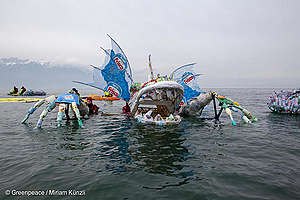
Greenpeace activists deliver a 20 meter long “plastic monster” covered in Nestlé branded plastic packaging to the company‘s global headquarters. Greenpeace is calling on Nestlé to end its reliance on single-use plastic.
Greenpeace activists delivered a 20-meter long plastic monster covered in Nestlé branded plastic packaging to the company‘s global headquarters in Switzerland on April 16, 2019.
So where did the plastic monsters originate? Nestlé. Nestlé and other multinational corporations produce massive amounts of single-use plastic packaging. As we all know, plastic is devastating communities, polluting natural environments, and threatening marine creatures around the world. Last year, Nestlé used 1.7 million tonnes of plastic packaging. And while their latest move is to try to argue the exact numbers, the simple fact remains that Nestlé produced more plastic last year than the year before.
This has got to stop. At a time when companies need to be focused on urgently reducing their overall plastic production, Nestlé continues to increase it, distracting concerned customers and the media with more talk of recycling and small reuse initiatives that are nowhere near the scale needed to actually make a dent in the obscene amount of plastic they are pumping out into the world. In fact, Nestlé was named one of the worst plastic polluters after cleanups and brand audits of plastic waste around the world in 2018.
So the plastic monsters woke up and decided to return home to Nestlé. A huge plastic monster, 20 meters long and covered in Nestlé’s plastic waste, appeared in the Netherlands in late March. From there it journeyed by boat toward Switzerland, stopping by a few cities in Europe as it travelled up the Rhine through Germany and France.
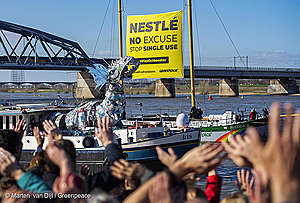
The ‘Beluga II’ and the Plastic Monster ship, which carries a huge artwork made of plastic waste, arrive at the Plastival. The event is a festival for a world without single-use plastic and includes vegan food trucks, workshops, talks, films, music and two Greenpeace vessels anchored at the Waalkade. A large banner at the event reads “Nestlé No Excuse Stop Single Use.” Nestlé produces 1.7 million tonnes of plastic annually.
On March 24, 2019, the Greenpeace ship Beluga II and a second boat carrying a huge plastic monster set sail from Nijmegen, Netherlands.
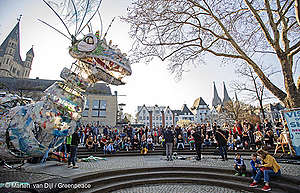
The Irish rock band The Riptide Movement plays at the open boat event. Greenpeace activists walk with the plastic monster to Greenpeace ship Beluga II. Greenpeace protest against single use plastic waste with a huge artwork made of plastic waste from the Philippines. The walk is part of the Beluga II tour on the river Rhine.
Mit einem Plastikmonster ziehen Greenpeace Aktivisten vom Liegeplatz der Beluga II zum Rheingarten , um gegen Plastikmuell zu protestieren. Das Monster besteht aus Muell, den Greenpeace-Aktivisten auf den Philippinen an den Straenden unbewohnter Inseln gesammelt haben. Der Großteil des Plastikmuells besteht aus Einwegverpackungen von Unilever, Nestlé und Procter & Gamble. Die irische Rockband The Riptide Movement spielt zur Open Boat vor der Beluga.
The plastic monster thrilled crowds in Cologne, Germany, on March 30, 2019.
On April 10, 2019, activists from the Break Free From Plastic movement delivered a plastic monster serpent along with an “invoice from the Filipino people” to Nestlé headquarters in the Philippines. The invoice outlined the costs of Nestlé’s single-use plastic packaging from impacts to human health, environmental pollution, death of wildlife, damage to livelihoods and businesses, greenhouse gas emissions, and waste management challenges.
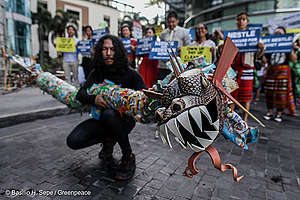
A serpent-like plastic monster is accompanied by environmental activists carrying placards as they troop to Nestle’s Philippine headquarters in Makati City, demanding accountability for its role in abetting the country’s plastic pollution crisis . Nestle was named one of the worst plastic polluters after cleanups and brand audits of plastic waste around the world in 2018.
The #Breakfreefromplastic movement delivered a demand letter and “invoice from the Filipino people” outlining the costs of Nestlé’s single-use plastic packaging to human health impacts, environmental pollution, death of wildlife, damage to livelihoods and businesses, greenhouse gas emissions, and waste management challenges.
On April 10, 2019, activists from the #BreakFreeFromPlastic movement delivered a serpent-like plastic monster to Nestlé’s Philippine headquarters in Makati City.
The next day, April 11, 2019, Greenpeace activists crashed the Nestlé AGM to demand that Nestlé end its reliance on single-use plastic, and invest immediately in alternative delivery systems based on refill and reuse. And on April 16, 2019, plastic monsters showed up with Greenpeace activists at Nestlé offices all around the world!
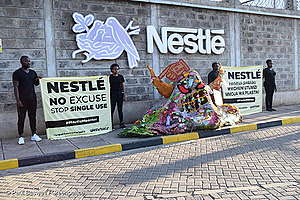
A team of Greenpeace Africa activists at Nestle’s headquarters in Nairobi, Kenya, bring the #PlasticMonster (an installation made with plastic waste), back to its maker. The activity is part of a global week of action calling on the multinational corporation to take concrete action to stop single-use plastic.
On April 16, 2019, a plastic monster appeared in Nairobi, Kenya, and the #plasticmonster hashtag was trending on social media in the country.
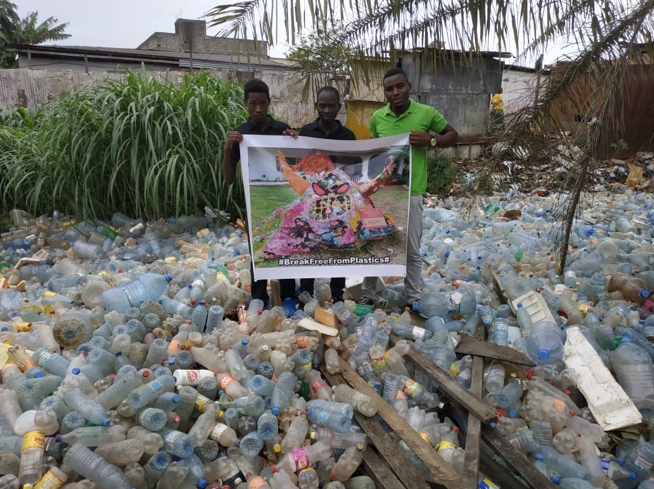
Activists in Cameroon held a banner showing the plastic monster and urging companies to #BreakFreeFromPlastic.
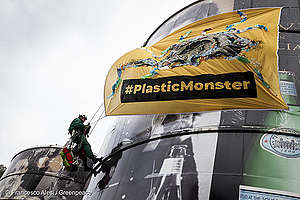
Greenpeace Italy activists protest at San Pellegrino plant, one of the main brand properties of Nestlé, asking Nestlé to stop polluting the planet with single-use plastic.
Greenpeace is demanding that Nestlé end its reliance on single-use plastic, and invest immediately in alternative delivery systems based on refill and reuse.
Also on April 16, 2019, Greenpeace Italy activists protested at the San Pellegrino plant, one of the main brand properties of Nestlé.
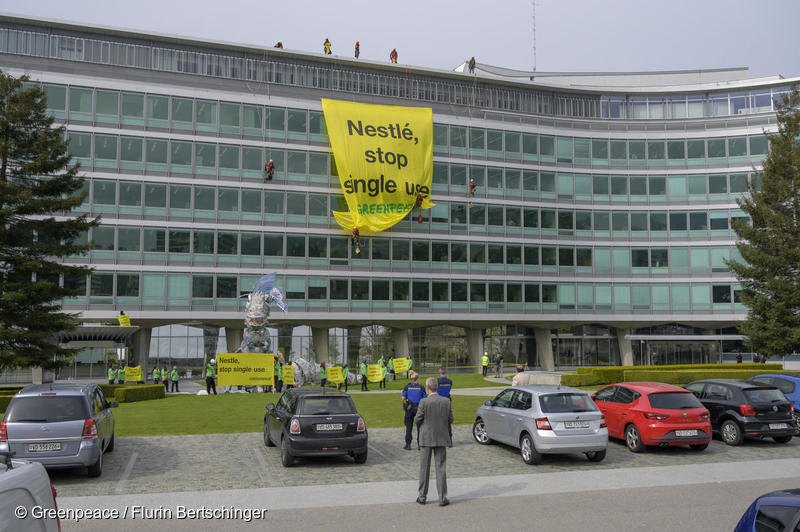
Greenpeace activists deliver a 20 meter long “plastic monster” covered in Nestlé branded plastic packaging to the company‘s global headquarters. Greenpeace is calling on Nestlé to end its reliance on single-use plastic.
The giant plastic monster finally arrived home to Nestlé’s global headquarters in Switzerland on April 16, 2019.
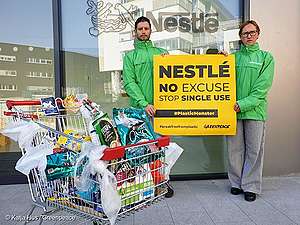
Activists visit Nestlé’s national office in Ljubljana, Slovenia, bringing them back a selection of plastic waste collected from Greenpeace supporters. The activity is part of Greenpeace’s Plastic Monster campaign calling on Nestlé to stop single-use plastic packaging and take meaningful steps towards reduction targets and offering large-scale alternative systems of refill and reuse.
Activists also visited Nestlé’s national office in Ljubljana, Slovenia, and brought back a selection of Nestlé’s own branded plastic waste collected from Greenpeace supporters.
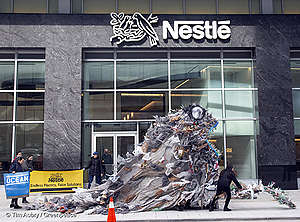
Greenpeace activists joined a 15-foot tall monster in a visit to Nestlé’s headquarters in Arlington, Virginia, delivering Nestlé plastic pollution gathered from streets, rivers, and beaches across the country and demanding that the company take responsibility for the over 1.5 million metric tons of single-use plastic it produces annually.
“It’s time for Nestlé to end its reliance on single-use plastics and move toward systems of reuse,” said Greenpeace Plastics Campaigner Kate Melges, who helped return the plastics to the company.
“Nestlé has created a monster by producing endless quantities of throwaway plastics that persist in our environment for lifetimes. It’s time for the company to own its mess and stop pushing false solutions that will never solve this crisis.”
In the U.S., Greenpeace activists delivered a plastic monster to Nestlé’s headquarters in Arlington, Virginia. The monster vomited Nestlé’s plastic pollution gathered from streets, rivers, and beaches across the country.
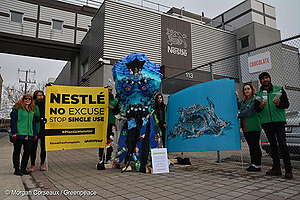
Greenpeace Canada activists unveiled a 9 foot long “plastic monster” covered in Nestlé branded plastic packaging to a Nestle factory in Toronto, as part of a global day of action against Nestlé. Greenpeace is calling on Nestlé to end its reliance on single-use plastic.
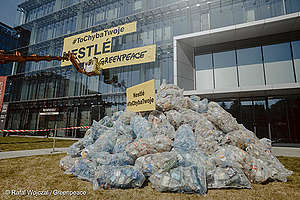
Greenpeace activists from Poland visit Nestlé HQ in Warsaw to deliver 350kg of plastic waste and show the company how much plastic it produces in 5 seconds. They display banners reading “Is this yours, Nestle?” and “We’re fed up with your plastic”.
The activity is part of a global week of actions calling on the corporation to end its reliance on single-use plastic.
The same day, Greenpeace activists visited Nestlé headquarters in Warsaw, Poland, to deliver 350 kg of plastic waste—the amount of plastic Nestlé produces in just 5 seconds. The banner reads “Is this yours, Nestlé?” and “We’re fed up with your plastic”.
But the plastic monsters weren’t done yet! On April 22, 2019, two more plastic monsters found their way home to Nestlé offices in Malaysia and Mexico.
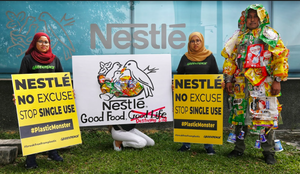
Greenpeace activists showed up at the Nestlé office in Malaysia on Earth Day to tell the company to stop single-use plastic.
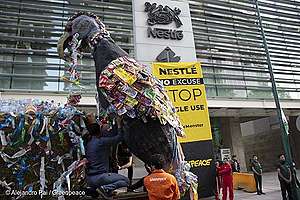
Greenpeace activists place a structure showing a monstrous bird feeding its young with plastic waste in front of Nestle’s headquarters in Mexico City. The activity is part of a global week of action calling on the corporation to end its reliance on single-use plastic.
Activistas se manifiestan fuera del corporativo de Nestlé en la Ciudad de México con una estatura de un pájaro monstruoso que alimenta a sus crías con residuos plásticos.
Con esta acción México se suma a una serie de visitas similares a los corporativos en otros 10 países para regresar a su dueño, Nestlé, la monstruosa cantidad de plástico que genera.
Also on April 22, 2019, Greenpeace activists arrived at Nestle’s corporate headquarters in Mexico City with a monstrous bird that feeds its young with plastic waste.
Amazing, right? These plastic monsters may not be real, but they represent a very serious crisis: the plastic monster is a reality in many communities, especially in Southeast Asia, which are being overwhelmed by the world’s plastic waste. You can help: Tell Nestlé to stop polluting our planet with single-use plastics, and share our video. You can even make your own plastic monster to let Nestlé and other big companies know it’s time to #BreakFreeFromPlastic!
Jen Fela is the global engagement lead for the Plastic-Free Future campaign at Greenpeace.

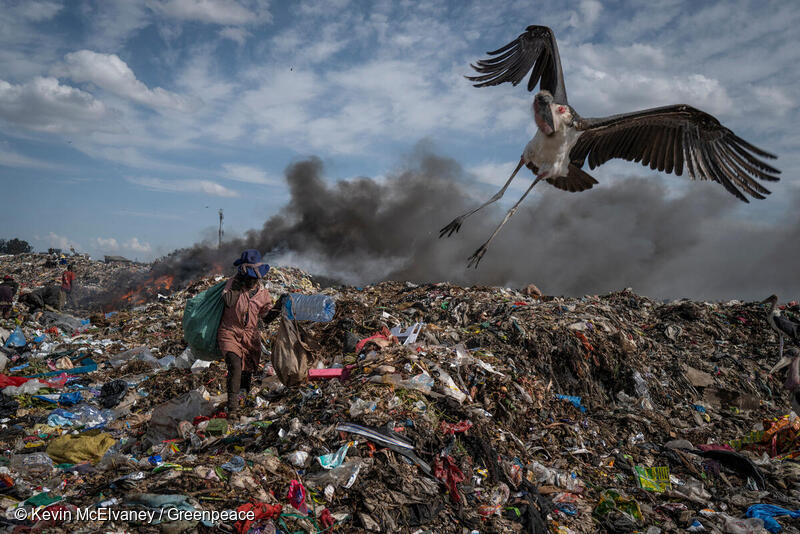
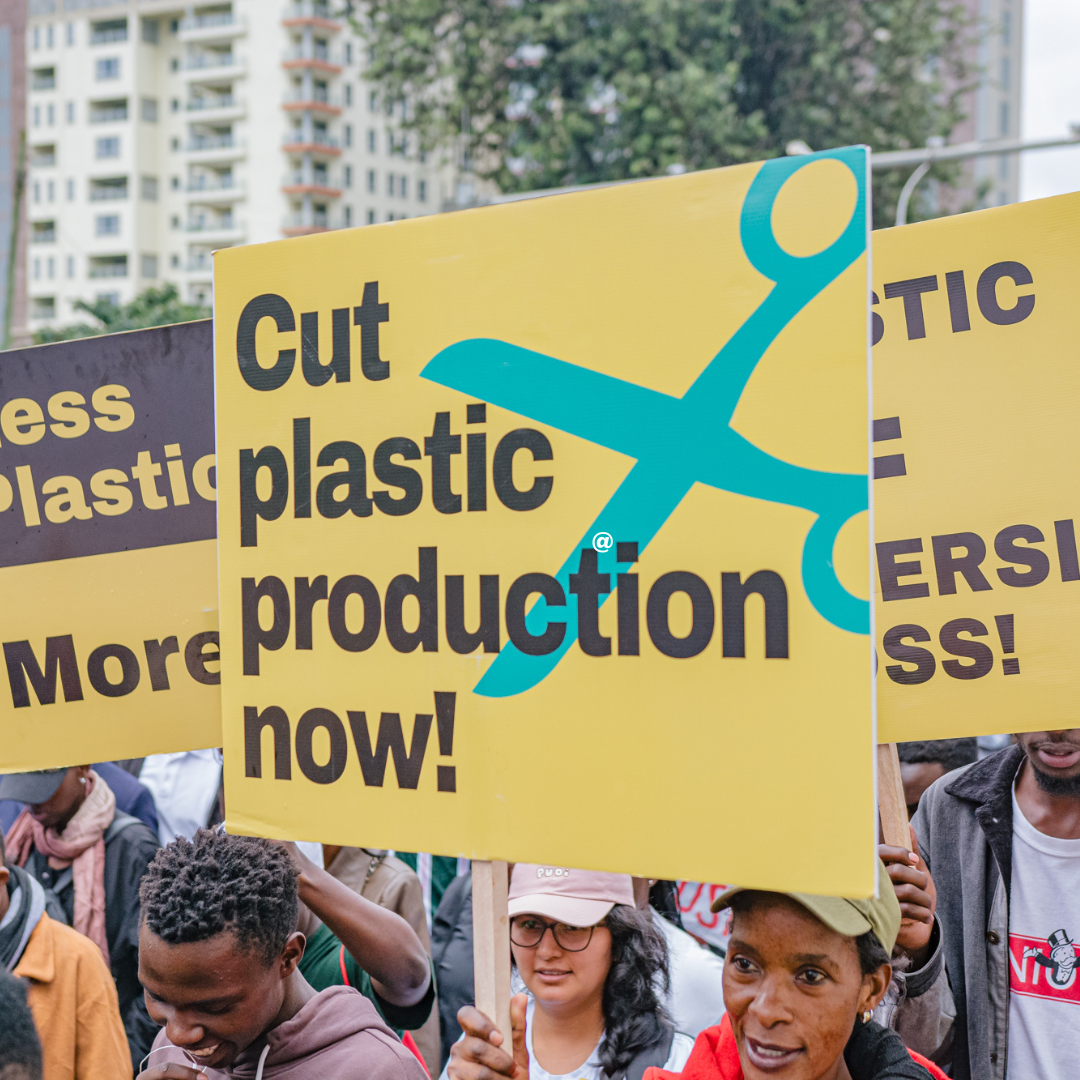
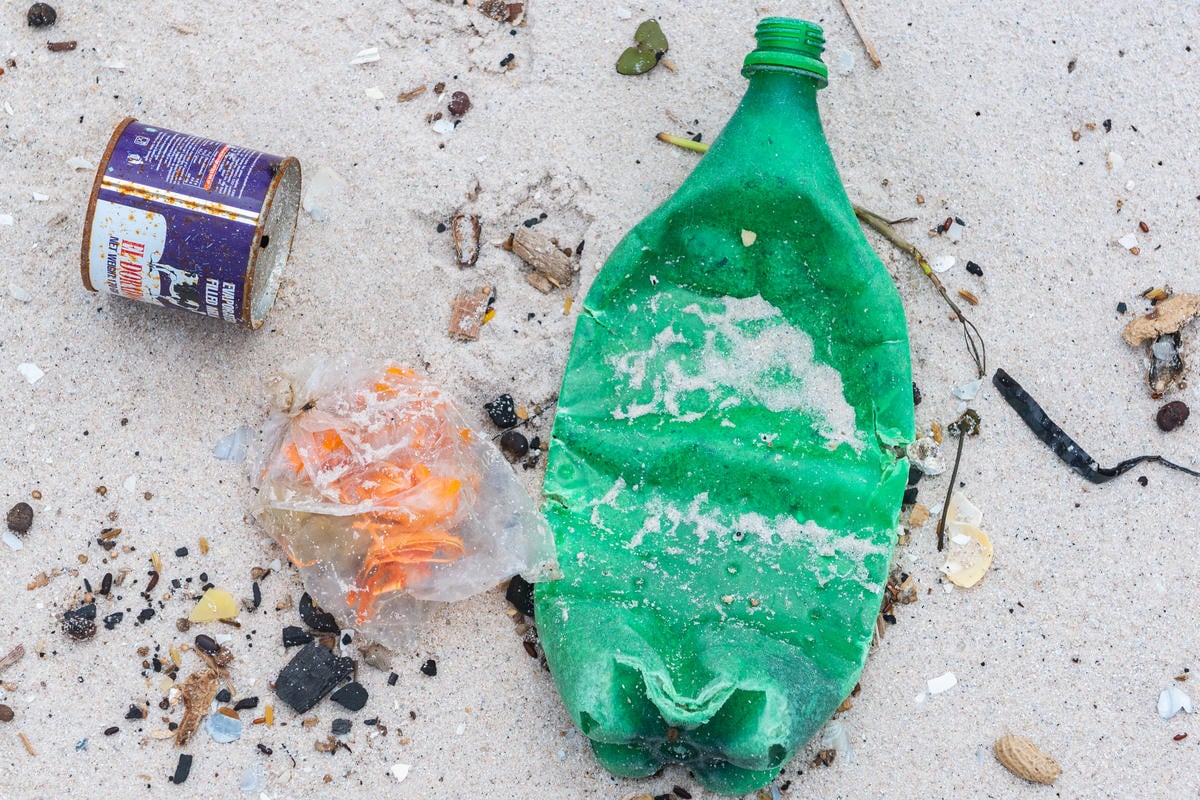
Discussion
its shocking and i want to make difference
Hello, I hope this message finds you well. My name is Laura Acevedo, and I'm an intern in GRID-Arendal, an organization that works under the United Nations and the Norwegian Government. We are currently creating a desktop study on Marine Litter in the West African coastline. I respectfully request your permission to use your excellent photograph of the activists in Cameroon, giving Greenpeace and the photographer the proper credits. I look forward to hearing from you soon, Best regards, Laura If you want to know more about the project, feel free to contact me to [email protected]
Hi Laura Please send us your request to [email protected]